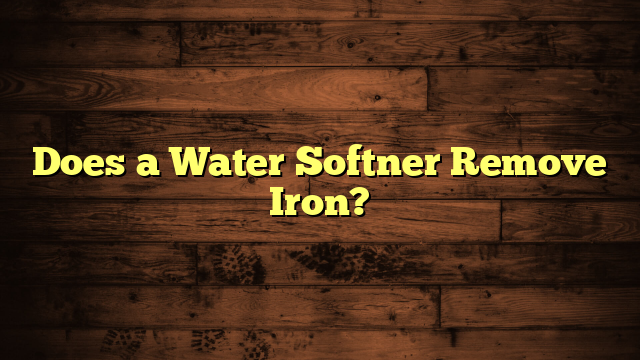Does a Water Softner Remove Iron?
You might not realize that water softeners can tackle low levels of ferrous iron, but they struggle with more complex forms. While these systems are effective at exchanging soluble iron for sodium, they fall short against ferric iron and certain bacterial types. This brings up questions about whether a standard water softener is enough for your needs or if you'll require additional filtration. Understanding the nuances of how these systems work can help you make informed decisions about your water quality. So, what should you know about the different types of iron and their impact?
Key Takeaways
- Water softeners primarily target calcium and magnesium, effectively managing low levels of ferrous iron (Fe²⁺).
- High concentrations of ferric iron (Fe³⁺) typically require additional filtration systems due to their insolubility.
- Water softeners are generally ineffective against organic and bacterial iron, necessitating specialized removal methods.
- Regular testing of water is essential to determine iron levels and identify appropriate treatment solutions.
- For effective iron removal, consider alternative systems like iron filtration or oxidation and filtration methods.
Understanding Water Softeners
Water softeners are vital tools for many households dealing with hard water. If you've noticed limescale buildup, dry skin, or dull laundry, you're likely facing water hardness issues caused by high mineral content, particularly calcium and magnesium.
These minerals can wreak havoc on your plumbing and appliances, leading to costly repairs over time.
By installing a water softener, you can greatly reduce the hardness in your water. This device works by exchanging these hard minerals for sodium ions, effectively softening your water and improving its quality.
You'll notice the benefits almost immediately: your soap will lather better, your dishes will sparkle, and your clothes will feel softer.
Understanding the mineral content of your water is important. Most municipalities provide a water quality report that details the hardness levels, allowing you to gauge whether a water softener is right for you.
Regular maintenance of your softener is also important to guarantee peak performance. As a result, you'll not only protect your home's plumbing but also enjoy the comfort of softer water in your daily life.
Investing in a water softener could be one of the best decisions you make for your household.
How Water Softeners Work
If you've ever wondered how water softeners transform your hard water into a more pleasant experience, you're not alone. Understanding the process can help you appreciate the benefits of softer water.
Here are three key components of how water softeners work:
- Ion Exchange: Water softeners utilize a method called ion exchange to replace hard minerals like calcium and magnesium with sodium ions.
- Resin Beads: Inside the softener, resin beads are coated with sodium ions. As hard water flows through, the beads attract and hold onto the hard minerals while releasing sodium into the water.
- Regeneration Cycle: Once the resin beads become saturated with hard minerals, the system undergoes a regeneration cycle, where a concentrated salt solution flushes the beads, restoring their sodium content.
This process hinges on water chemistry, as the chemical interactions between ions dictate how effectively the softener operates.
By understanding the mechanics behind ion exchange, you can make informed decisions about your water quality.
Ultimately, water softeners not only improve your water's feel and taste but also protect your plumbing and appliances from the damaging effects of hard water.
Types of Iron in Water
When it comes to iron in water, understanding the different types is essential for maintaining water quality.
You'll encounter ferrous iron, ferric iron, and organic forms, each affecting your water differently.
Knowing the concentration levels of these iron types helps you choose the right treatment solutions for your home.
Types of Iron
Several types of iron can be found in water, each with unique characteristics and implications for water quality. Understanding these types is essential for addressing any issues related to iron content in your water supply.
Here are the three main types of iron you might encounter:
- Ferrous Iron (Fe²⁺): This is the soluble form of iron, which often exists in water when it comes from wells or underground sources. It typically appears clear but can oxidize and turn reddish when exposed to air.
- Ferric Iron (Fe³⁺): Unlike ferrous iron, ferric iron is insoluble and tends to form reddish-brown particles. It commonly appears when ferrous iron oxidizes, leading to staining issues in fixtures and laundry.
- Organic Iron: This type binds with organic matter in water, which can complicate its removal. It may not cause staining but can affect taste and odor.
Iron Concentration Levels
Understanding iron concentration levels in your water is essential for effective treatment and maintenance. Different types of iron can show varying concentration levels, which impacts the best iron removal methods. To address these issues, conducting iron concentration testing is vital. Here's a simple overview of the common types of iron found in water:
| Type of Iron | Concentration Level (mg/L) | Common Removal Methods |
|---|---|---|
| Ferrous Iron | 0.1 – 5.0 | Oxidation and Filtration |
| Ferric Iron | 0.1 – 10.0 | Sedimentation and Filtration |
| Bacterial Iron | 0.1 – 2.0 | Chlorination and Filtration |
When you identify the type and concentration of iron in your water, you can choose the appropriate iron removal methods. For instance, ferrous iron often requires oxidation to transform it into ferric iron, which can then be filtered out. Knowing these details enables you to maintain better water quality and prolong the life of your water system. Remember, regular iron concentration testing is key to addressing any iron-related issues effectively.
Impact on Water Quality
The presence of different types of iron in your water can considerably impact its quality and your overall experience. Understanding these variations is vital because they affect both water clarity and aesthetic concerns.
Here are three types of iron you might encounter:
- Ferrous Iron (dissolved): This form is usually not visible, but it can cause rust stains when it oxidizes.
- Ferric Iron (particulate): Unlike ferrous iron, ferric iron can be seen as reddish-brown sediment, impacting your water's clarity.
- Organic Iron: Often accompanied by tannins, this type can impart a yellowish color, affecting both clarity and taste.
When you have high levels of iron, you'll likely notice a decrease in water clarity, leading to cloudy or discolored water.
These aesthetic concerns can deter you from drinking or using water for cooking, which can be frustrating.
While a water softener may help reduce some forms of iron, it's important to identify the type present in your water.
This knowledge will guide you in choosing the right treatment method to guarantee clean, clear, and aesthetically pleasing water for your home.
Effectiveness Against Iron
How effective are water softeners at removing iron from your water supply?
Water softeners primarily target hard minerals like calcium and magnesium, but their softener effectiveness against iron can vary. If you have low levels of iron, a standard water softener may work well enough for iron removal. However, when dealing with higher concentrations of iron, these systems often fall short.
The effectiveness of a water softener in removing iron depends on the type of iron present.
Ferrous iron, or dissolved iron, is more easily managed by a softener, as it can be exchanged with sodium ions during the softening process. On the other hand, ferric iron, or oxidized iron, tends to clump together and may not be effectively removed by a standard softener. In such cases, you might need to take into account additional filtration systems.
If you want to guarantee the best iron removal, it's critical to know your water's specific iron content.
Regular testing can help you determine the best solution for your situation, whether it's enhancing your softener system or opting for a specialized iron filter.
Limitations of Water Softeners
While water softeners are great for addressing hard water, they do have limitations you should know about.
They typically don't handle all types of iron effectively, and their capacity can vary, impacting overall efficiency.
Understanding these factors is vital to guarantee you choose the right solution for your water quality issues.
Iron Types Addressed
Which types of iron can water softeners effectively address? Understanding this can help you determine if a water softener is the right choice for your home.
While water softeners primarily target hardness minerals, they can also deal with certain types of iron, though with limitations. Here are three iron types to evaluate:
- Ferrous Iron (Dissolved Iron): This is the most common form that water softeners can remove. It's typically found in water as a soluble mineral.
- Ferric Iron (Oxidized Iron): Unfortunately, water softeners aren't effective here since it's not dissolved and requires different iron filtration methods.
- Bacterial Iron: This type is associated with bacteria in your water supply. Water softeners won't help you with this, as you'd need specialized iron removal techniques to deal with it.
Capacity and Efficiency
When considering a water softener for iron removal, it's important to understand the limitations of these systems. First, capacity considerations play a vital role in determining how effectively a softener can handle iron. Most residential water softeners have a limited capacity for iron, typically around 3 to 5 parts per million (ppm).
If your water exceeds this level, you might find the system struggling to keep up, leading to reduced effectiveness.
Additionally, efficiency ratings of water softeners vary, and not all are designed to manage iron well. Many systems focus primarily on hardness removal, which means they could overlook iron buildup.
If you're facing high iron content, investing in a specialized iron filter or a dual-purpose system might be necessary.
Keep in mind that while water softeners can help with minor iron issues, they're not a one-size-fits-all solution. Regular maintenance and monitoring are essential to guarantee your system operates efficiently.
Alternative Solutions for Iron
Exploring alternative solutions for iron removal can lead you to effective methods that don't rely solely on traditional water softeners. If you're dealing with iron in your water, consider these options:
- Iron Filtration Systems: These systems effectively remove iron from your water through various filtration techniques. They target dissolved iron, preventing rust stains in your fixtures.
- Oxidation and Filtration: By introducing an oxidizing agent, you can convert dissolved iron into solid particles. Once oxidized, you can filter out the iron, ensuring cleaner water.
- Chemical Treatments: Rust removal methods like using phosphates or polyphosphate compounds can help keep iron in solution, reducing staining and buildup in pipes and appliances.
Each of these alternatives offers distinct advantages depending on your specific water quality and needs.
Iron filtration systems are particularly popular for their efficiency and effectiveness.
By exploring these methods, you can find a solution that minimizes iron-related issues in your home while maintaining water quality.
Testing Your Water
Testing your water is an essential step in identifying iron levels and other contaminants that could affect your household. By knowing exactly what's in your water, you can make informed decisions about treatment options.
You can easily conduct water testing using simple test kits available at local hardware stores or online. These kits are user-friendly and typically come with detailed instructions, ensuring you get accurate results.
When you use a test kit, you'll measure various elements, including iron, pH levels, and hardness. Just follow the instructions carefully, and in a short time, you'll know if iron is present and at what concentration.
If you find high levels of iron, it might be a sign that you need to contemplate filtration or softening systems.
Choosing the Right System
Choosing the right system for water softening and iron removal can feel overwhelming, but it doesn't have to be. To simplify your decision-making process, consider the following key factors:
- Water Quality: Assess your water hardness and iron content through testing. This will guide your system selection.
- System Type: Decide between salt-based softeners, which are effective for high iron levels, or salt-free systems, which may work for softer water.
- Installation Considerations: Think about the space you have available and whether you'll need professional installation or can handle it yourself.
When you understand your specific needs, it becomes easier to choose a system that aligns with your requirements.
Look for systems that specifically mention iron removal capabilities, as not all water softeners can handle this issue effectively.
Also, pay attention to the maintenance requirements; some systems need more frequent upkeep than others.
By weighing these factors carefully, you'll be better prepared to make an informed decision that improves your water quality and overall satisfaction.
Happy softening!
Frequently Asked Questions
Can Water Softeners Remove Rust Stains From Fixtures?
While water softeners help with mineral buildup, they won't effectively remove rust stains from your fixtures. For rust removal, you'll need specific cleaners or methods tailored for fixture care to keep them looking their best.
How Often Should I Regenerate My Water Softener?
Did you know that water softeners typically regenerate every 3 to 7 days? To maintain ideal settings, adjust your regeneration frequency based on water hardness and usage, ensuring your system runs efficiently and effectively.
Do Water Softeners Affect Water Taste?
Water softeners can impact water quality and taste preferences. While some people enjoy the smoother feel, others might notice a slight change in flavor due to the sodium used in the softening process. It varies by individual.
Can I Use a Water Softener With Well Water?
Yes, you can use a water softener with well water. It helps prevent mineral buildup and can improve water quality. However, for iron removal, you might need a separate filtration system to address that issue effectively.
What Maintenance Is Required for Water Softeners?
Imagine you're a cowboy tending to your ranch; regular softener cleaning and resin replacement keep your water softener running smoothly. Check salt levels monthly, and schedule service annually to guarantee peak performance and longevity.
Conclusion
In conclusion, while a water softener can tackle low levels of ferrous iron effectively, it falls short against ferric iron and bacterial iron. You can rely on it for minor iron issues, but for higher concentrations, you'll need additional treatment solutions. Remember, understanding your water quality is key—testing your water and choosing the right system can make all the difference. So, for best results, be informed, be proactive, and guarantee your water is as clean and safe as possible.







